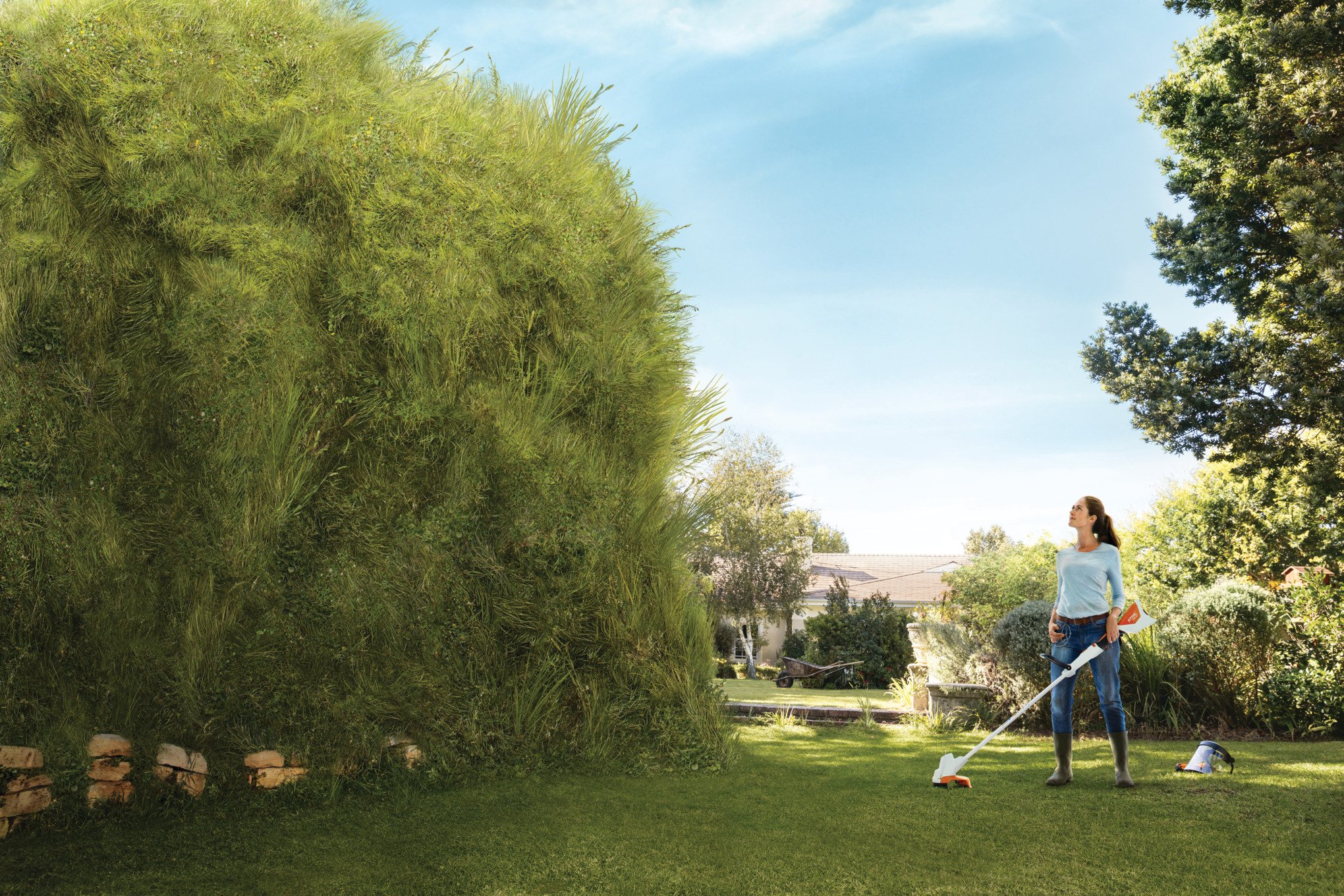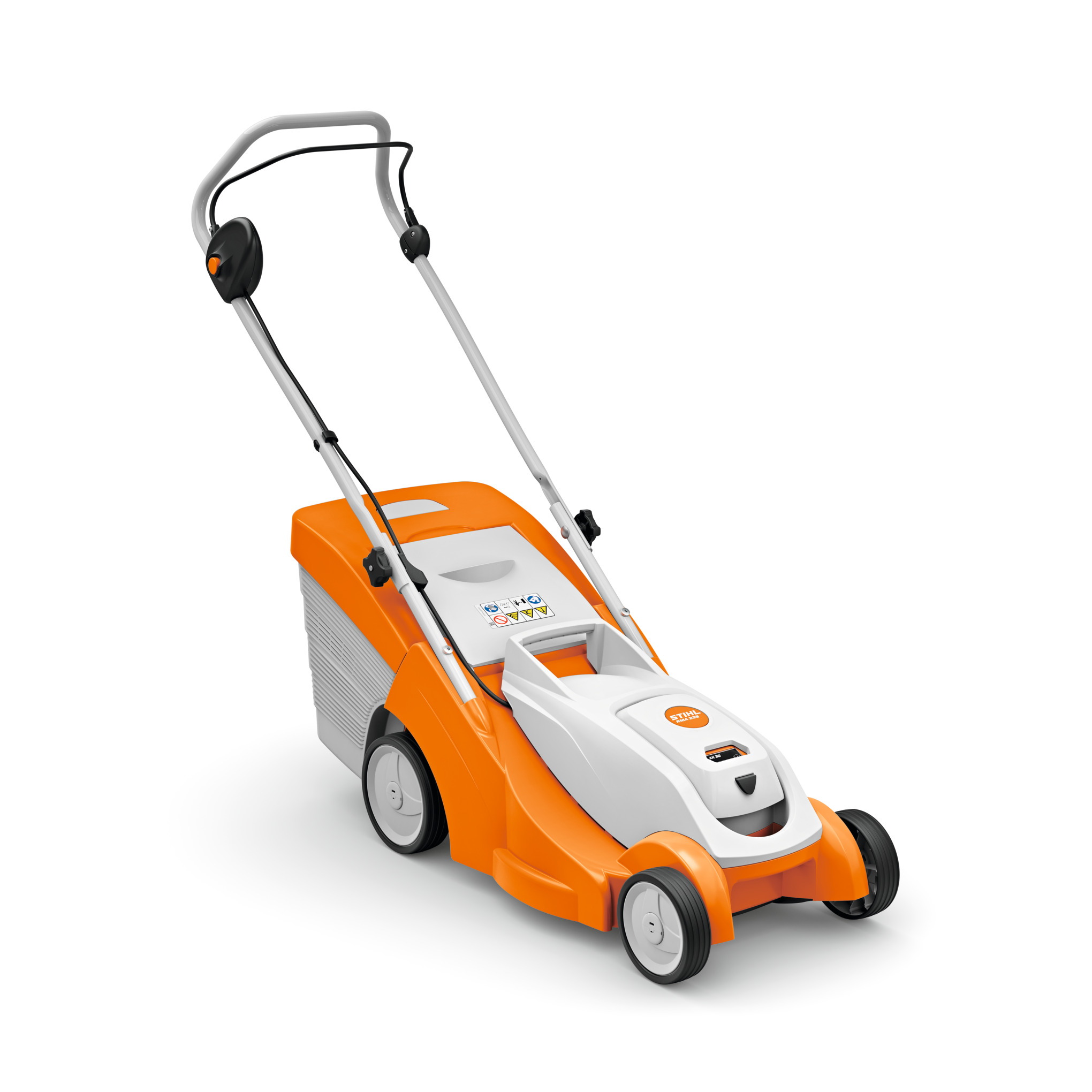Mulching grass – natural care for a lush green lawn
Lawn mulching is when grass chopped up by a mulching mower is left behind as a loose layer on top of the soil. The grass then draws the best nutrients from it.
15.10.2024

Overview: mulching lawn
- In mulching, organic material is spread on top of the soil to become a source of nutrients.
- Making your own mulch from garden waste
- Make sure you use the right mulching material for the various areas of your garden
- Mulch mowing: fine grass clippings are spread directly on the soil
- Mulch mowing saves time and money and is good for the environment
Mulching describes the spreading of shredded plant matter or other material as a loose layer on top of the soil. Mulch protects the earth and feeds nutrients back into it.
As with normal lawn mowing, you should mulch your grass at least once a week during the growing season. However it can sometimes be practical to mulch more often – particularly in spring, when the grass grows especially quickly. Make sure that your grass is not too long so you don’t get an excessive quantity of clippings all at once.
You can begin mulching your grass as soon the gardening season begins in spring. You can then use your mulching mower regularly until autumn – at least once a week.
What is mulching?
In organic gardening, mulch refers to organic material such as leaves or grass cuttings that is returned to the soil to protect it and provide a source of vitamins. So mulching means spreading shredded plant matter onto soil as a loose top layer. Mulching can be used in almost any garden area and not only means less effort and time for hobby gardeners, but can also save money. With a mulching mower for example, you can mow your lawn and mulch it at the same time. But vegetable gardens also benefit from mulching.
How does mulching work?
Mulching ensures soil retains moisture and remains shaded, allowing it to store water more efficiently so that it remains loose and does not dry out as quickly. The mulch also acts as a protective layer in heavy rain and cold temperatures, helping plants to grow. Finally, earthworms and other soil-dwelling organisms convert the mulching material into a valuable natural fertiliser which supplies lawn and vegetable beds with important nutrients for healthy growth.
Mulching material
Of course it’s possible to buy a wide variety of mulching materials from retailers, ranging from bark chippings to sawdust. However, your hard work in the garden means you are probably already ideally equipped with typical “garden waste”, which you can reuse as valuable mulch; so you can easily mulch your grass by leaving the cuttings behind after mowing the lawn.
Grass clippings
Grass clippings can be applied as mulch on all areas of the garden; the layer should be two to three cm thick for flowerbeds and plants. Make sure that you do not apply too thick a layer, as the cuttings may clump together if you do, reducing soil respiration. In addition, you should never use diseased grass or grass clippings that contain seeds.
Wood shavings
The high levels of nitrogen produced when woody shavings decompose can slow plant growth. It is especially suitable for mulching deeply-rooted hedges and trees, but also makes an ideal natural surface covering for pathways in the garden.
Foliage
You can happily use leaves from birch, sycamore, beech and all fruit varieties as mulch. However, leaves from walnut trees and oak should only be used in small quantities and mixed with other leaves, as the tannin they contain is difficult to break down and changes the nutritional balance in the soil for the worse.
Bark chippings
Bark chippings are especially effective at suppressing thistles and other weeds, but only suitable for pathways and areas under flowers, fruit trees and bushes because of the tannin and other acids they release into the soil. You should never use bark mulch for vegetables or perennials. To be effective, you should apply a layer at least ten centimetres thick.
Gravel, grit and stones
Gravel, grit and stones are ideal mulching materials for long-lived herbs, shrubs and perennials. They are inexpensive and offer good water and air permeability, but due to their weight they are not suitable for very dense soils. We recommend you use a lighter-coloured variety in sunny locations, as this will not heat up so quickly, while dark-coloured variants will store heat for longer.
Mulching grass – mow and mulch in one go

Your lawn will also benefit from organic mulch. Mulch mowing not only supplies your lawn with natural nutrients, but can also save you time and money. This is because with mulch mowing, the clippings are not collected in the lawn mower’s grass collection box, but instead chopped finely by the blades of the mulching mower and distributed over the turf. This process combines three important lawn care steps – mowing, disposing of clippings and fertilising – into a single one, thereby protecting both the environment and your wallet.

Mulching grass: advantages
A long-term experiment by the University of Natural Resources and Life Sciences in Vienna-Essling found that mulch mowing offers significant advantages and promotes grass growth. Over a period of four years, a 1,000-square-metre lawn was mown with a standard lawn mower and the clippings consistently disposed of; the area was well-fertilised with mineral fertilisers. At the same time, a lawn of equal size was mown with a mulching mower and the cuttings left on the surface to mulch the lawn. The result is impressive:
- consistently thicker grass cover and a richer green colour as a result of the 21 mulch mowing cuts per year throughout the entire growing season.
- Higher effectiveness than the 4 applications of mineral fertiliser on the control area.
- The nutrients returned to the soil correspond exactly to the optimum amount required, both in terms of quantity and proportion to each other.
Good reasons for the ever-increasing popularity of grass mulching
- When you mulch your grass, lawn thatch is also reduced thanks to improved grass growth. A lawn that is well supplied with nutrients leaves no room for weeds or moss. The original species composition is retained.
- A healthy growing lawn produces around two kilos of clippings per square metre per year – that’s one and a half to two tonnes for a 1,000 m² lawn! Disposal via the green bin or composting is not always possible – this is another reason why mulching the lawn is becoming increasingly popular.
To mulch or mow?
Mulching actually means loosely covering the soil with mainly organic material. This means that instead of “To mulch or mow?”, we should be asking: “To mulch mow or mow with a collection box?”
Both methods – mowing and mulch mowing – have their advantages and disadvantages, which we will outline below. On the basis of the differences between mulch mowing and mowing, you can decide whether you should mulch your lawn with the grass clippings or collect them during or after mowing instead.
The difference: mulch or mow?
During conventional mowing, the blades of grass you have cut are either left on the surface of the soil as coarse, long clippings or collected in the grass collection box attached to the mower, which is emptied regularly. These grass clippings can be composted so that the nutrients contained in the grass can benefit your garden once again.
During mulching, on the other hand, the grass is finely shredded during the mowing process. The cuttings then remain on the ground. During mulching, the grass and soil benefit from having the nutrients returned to them, meaning there is no need to add fertiliser.
Mulch or mow: advantages and disadvantages
| advantages | Disadvantages | |
|---|---|---|
| Mulch mowing |
|
|
| Mowing |
|
|
Mulch or mow: which machine is best?
If you are wondering whether mulching or mowing is better for your lawn, you will sooner or later find yourself needing to decide which machine is best for you: should you get a lawn mower or a mulch mower or lawn mower with a mulching function?
STIHL mulch mowers shred cuttings especially finely and spread them evenly on the soil. Alternatively, you can quickly convert your STIHL lawn mower into a mulch mower and equip it with various blades. This is a quick, simple process for most lawn mowers, by means of our mulching kits – and it means you don’t need to decide whether to get a lawn mower or a mulch mower.
Conclusion: Mulching saves you the bother of emptying the grass collection box and means your compost heap is not as big, as there are no grass clippings. If you mulch your lawn instead of just mowing it, you will also need to use much less lawn fertiliser, since the nutrients remain on the surface.
However, mulching is more time-consuming, particularly during warm, humid growing weather, as it needs to be done at least twice a week for the clippings to really be broken down. And if you cannot mow your lawn because of rain, you should cut longer grass in several stages so that the grass clippings will be fine enough and will not cause lawn thatch to form. In terms of time then, mowing has the upper hand.
Mulch mowers – making garden work easier, improving grass health
Mulching grass: Other tips
If you want to achieve the best possible results when mulching grass, it is important to ensure that the clippings remain on the surface of the lawn. Please take care that the volume of cuttings is not too high and that they are finely shredded and evenly distributed. The nitrogen they contain will quickly be mineralised and made available to plants once more. When mulching grass however, you should pay attention to the following tips in order to get the maximum benefit possible from the method:
- Cut the grass a little more often when mulch mowing.
- Use a special STIHL mulch mower. This will shred the cuttings especially finely and distribute them evenly. Alternatively, STIHL also offers mulching kits for most lawn mowers that allow them to be converted to mulching mowers.
- When mowing, you should cut the grass by around a third of its length, and less in periods of drought.
- Where possible, you should cut the grass when it is dry. If the grass is damp, mow a little more slowly and do not cut it as short.
- Always work at top speed (full throttle) with well-sharpened blades.
- Inspect your mower housing regularly and clean off any clippings that have stuck to it.
- Ensure that you mow in overlapping strips.
- Always mow very long grass in multiple stages.
- Be sure to vary the direction in which you mow. This will ensure you cover the garden more effectively and that the cuttings are distributed more evenly.

Vegetable garden mulching
A mulch mix that is applied regularly is ideal for vegetable patches. Keep it sparing – the mulch also attracts snails and voles. It’s better to mulch the garden more often and with different materials to support the growth of your plants. Make sure that grass and other green cuttings are always slightly dried out before spreading them on the vegetable patch.
Mulch mix for your vegetable patch:
- undersowing and underplanting
- Foliage
- Straw
- Compost
- Grass clippings
- Ideal: radishes, herbs, cress














